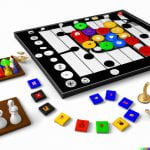Ludo, often referred to as “the classic board game,” has been a beloved pastime for generations. Its origins can be traced back to ancient India, where it was known as Pachisi. The game eventually spread to other parts of the world and underwent several transformations before becoming the Ludo that is widely recognized today.
The game is played on a colorful board with four colored pieces per player, which must navigate around the board based on the roll of a die. Despite its simplicity, Ludo has captured the hearts of players from all walks of life and continues to be a popular choice for family game nights, gatherings with friends, and even professional competitions.
In this article, we will delve into the history and origins of Ludo, explore its rules and gameplay, examine its influence on modern board games, look at different variations of the classic game, and discuss strategies for winning. We will also highlight how playing Ludo fosters social interaction and analyze its appearances in pop culture.
Whether you are new to the game or a seasoned player looking to deepen your understanding, this article aims to provide comprehensive insights into the enduring appeal of Ludo.
How to Play Ludo
Ludo is a classic board game that has been enjoyed by people of all ages for generations. The game originated in India, where it was known as “Pachisi,” and has since spread around the world, gaining popularity in various countries. Ludo is a game of strategy and luck, making it an exciting and enjoyable pastime for players.
The game is typically played on a square board with a pattern of cross-shaped paths, divided into four different colored sections. Each player has four tokens, which they must move around the board from their starting area to the center, following a predetermined path. The goal is to be the first player to move all four of their tokens into the center of the board.
To start the game, each player takes turns rolling a die and moving their tokens according to the number rolled. Players can only move their tokens out of the starting area when they roll a six.
If a player’s token lands on a space already occupied by an opponent’s token, the opponent’s token is sent back to its starting area. This adds an element of competition and tension to the game as players race to get all their tokens into the center while trying to impede their opponents’ progress.
Ludo is a game that combines elements of strategy and chance, making it engaging for players of all ages. The simple rules and fast-paced gameplay make it easy for new players to learn and enjoy. Whether sitting around with family or friends or at social gatherings, playing Ludo brings people together in friendly competition and fun. It’s no wonder this classic board game continues to be cherished by so many people worldwide.
| Ludo Facts | Details |
|---|---|
| Origin | India |
| Number of Players | 2-4 |
| Mechanics | Dice rolling, strategic movement |
The Influence of Ludo on Modern Board Games
Ludo, the classic board game that originated in India, has had a significant influence on modern board games. The simple yet strategic gameplay of Ludo has inspired many game designers and developers to create their own versions of this beloved game. This influence can be seen in the design and mechanics of many modern board games.
Design Elements
The colorful and vibrant design of Ludo, with its distinctive board and playful tokens, has had a major influence on the visual appeal of modern board games. Many contemporary games have drawn inspiration from Ludo’s aesthetic, incorporating bright colors and engaging themes to attract players of all ages.
Mechanics and Gameplay
The basic mechanics and gameplay elements of Ludo, such as dice rolling and token movement, have also made their way into modern board games. Game designers have borrowed these core elements and adapted them to create new and innovative gaming experiences. The simplicity of Ludo’s rules and gameplay has served as a foundation for the development of countless new board games.
Casual Gaming Culture
Ludo’s influence is also evident in the rise of casual gaming culture. The accessibility and enjoyment provided by Ludo have paved the way for the popularity of similar casual board games in today’s society. Modern board games often aim to capture the same spirit of fun and social interaction that has made Ludo a timeless favorite.
Overall, it is clear that Ludo has left an indelible mark on the world of modern board games. Its influence can be seen not only in specific design elements and mechanics but also in the broader cultural impact it has had on gaming communities around the globe.
Ludo Variations
Ludo has a rich history and has evolved over time, resulting in various versions of the classic game being played across different cultures and regions. These variations provide unique twists to the original game, offering diverse gameplay experiences to players.
Regional Variations
In India, a variation of Ludo known as “Pachisi” is widely popular, and its origins can be traced back to the ancient Indian game of “Chaupar”. This version typically involves a cross-shaped board and the use of cowrie shells as dice.
In Colombia, a variation called “Parqués” is played with two dice instead of one, adding an element of unpredictability to the game. These regional adaptations highlight how Ludo has been embraced and customized by different cultures, contributing to its widespread appeal.
Theme-Based Versions
With the surge in popularity of modern board games, several themed variations of Ludo have emerged. Themes range from popular movies and TV shows to iconic characters and landmarks. These versions often feature custom-designed boards, tokens, and cards that align with the chosen theme. Players can immerse themselves in their favorite fictional worlds while enjoying the familiar mechanics of the classic Ludo game.
Modified Gameplay Variants
Some versions of Ludo include modified gameplay elements that add complexity or excitement to the traditional rules. For example, “Chinese Checkers” is a variant that utilizes star-shaped game boards and strategies similar to those used in traditional Ludo. Additionally, there are speed-based variations where players must race against the clock to reach their home bases, introducing an element of urgency and competition.
These different versions of Ludo showcase its adaptability and enduring nature as a beloved classic board game enjoyed by people worldwide. Whether playing a regional variation rooted in tradition or exploring themed adaptations that cater to specific interests, players can find endless enjoyment through the diverse iterations of this timeless pastime.
Ludo Strategy and Tips for Winning
Ludo is a classic board game that has been enjoyed by people of all ages for decades. While luck plays a significant role in the outcome of the game, there are also strategies and tips that players can employ to increase their chances of winning.
One important strategy in Ludo is to prioritize getting all your pieces out of the home base. This may involve moving one piece further along the board instead of moving another piece into a safe zone. It’s important to balance the risk of getting your pieces captured with the reward of advancing them closer to the finish line.
Another key strategy is to block your opponents whenever possible. By placing your pieces strategically, you can prevent your opponents from moving theirs, which can give you an advantage in reaching the finish line first.
Additionally, it’s crucial to keep an eye on all the pieces on the board, not just your own. Pay attention to your opponents’ moves and plan your own moves accordingly. Observing the board and anticipating your opponents’ next moves can give you a significant edge in the game.
| Ludo Strategy | Tip for Winning |
|---|---|
| Prioritize getting all pieces out of home base | Balance risk and reward when advancing pieces |
| Block opponents whenever possible | Prevent opponents from advancing their pieces |
| Observe all pieces on the board | Anticipate opponents’ next moves |
The Social Aspect of Playing Ludo
Ludo, also known as Parcheesi in some countries, has been bringing people together for decades. This classic board game has the power to unite family and friends, creating an atmosphere of fun and friendly competition. Whether played in a casual setting or during a special occasion, Ludo has a unique way of fostering camaraderie and bonding among its players.
The social aspect of playing Ludo is evident in its ability to bring people of all ages and backgrounds together. This timeless game transcends generations, allowing grandparents to play with their grandchildren and friends to engage in lighthearted gameplay. The simple rules and easy-to-understand mechanics make it accessible to everyone, regardless of their skill level or familiarity with board games.
When playing Ludo, players have the opportunity to interact with each other, share laughs, and create lasting memories. The game’s competitive nature often leads to friendly banter and excitement as players strategize and take calculated risks. Additionally, the act of rolling the dice and moving pieces across the board encourages conversation and engagement among participants. Overall, Ludo serves as a catalyst for social interaction and connection, making it a beloved pastime for gatherings and get-togethers.
- Ludo encourages interaction among players of all ages
- The game fosters camaraderie and bonding among family and friends
- Players engage in friendly banter and create lasting memories while playing
Ludo in Pop Culture
Ludo, the classic board game, has made numerous appearances in popular culture over the years. From television shows to movies and even music, this timeless game has left its mark on various forms of media. Here are some notable references and appearances of Ludo in popular culture:
- Movies: Ludo has been featured in several movies, often as a symbol of family bonding or friendly competition. In the 1984 film “A Passage to India,” a group of characters is shown playing Ludo, highlighting the universal appeal of the game across different cultures and time periods.
- Television: Ludo has also been depicted in various TV shows as a source of entertainment for characters. In an episode of the popular series “The Big Bang Theory,” the main characters engage in a heated game of Ludo, showcasing the game’s ability to bring people together and create lighthearted fun.
- Music: Ludo’s influence can even be found in music. The American rock band “Ludo” took inspiration from the game when choosing their name, reflecting the widespread recognition and impact of this classic board game.
These examples demonstrate how Ludo has become ingrained in popular culture, showing its enduring relevance and significance beyond just being a traditional board game. Its appearances in various forms of media serve to further solidify its status as a beloved classic that continues to capture people’s interest and imagination. Whether it’s on screen or through music, Ludo’s presence remains influential and timeless.
The Enduring Appeal of Ludo
In conclusion, the classic board game Ludo continues to capture the hearts of players around the world due to its enduring appeal and timeless charm. Its origins may be traced back thousands of years, but its simple yet engaging gameplay has stood the test of time. The game’s ability to bring people together and create lasting memories is a major factor in its popularity, as it remains a beloved pastime for families and friends.
Despite the countless modern board games available today, Ludo’s influence on the gaming world is undeniable. Its impact can be seen in various modern board games that have adopted similar mechanics or even variations of Ludo itself. This demonstrates the game’s significance and lasting legacy in the realm of traditional tabletop gaming.
Additionally, Ludo has made considerable appearances in pop culture, cementing its status as an iconic board game. From references in books and movies to being featured in popular media, Ludo has undoubtedly become an integral part of entertainment culture. Overall, Ludo’s ability to bring people closer together and provide endless hours of fun ensures that it will continue to be cherished by generations to come.
Frequently Asked Questions
How Do You Play Classic Ludo?
Classic Ludo is played on a square board with a pattern of cross-shaped paths divided into four quadrants. Each player has four tokens that they must race around the board to get home.
What Is the Traditional Game Ludo?
Ludo is a traditional board game that originated in India in the 6th century. It is a game of strategy and luck, where players race their tokens around the board using dice rolls to determine their moves.
What Is Ludo Called in the US?
In the US, Ludo is known as “Parcheesi.” The gameplay is similar to Ludo, with players racing their pieces around the board, trying to be the first to get all of their pieces to the end.

I love playing all kinds of games – from classics like Monopoly to modern favourites like Ticket to Ride.
I created this blog as a way to share my love of board games with others, and provide information on the latest releases and news in the industry.





